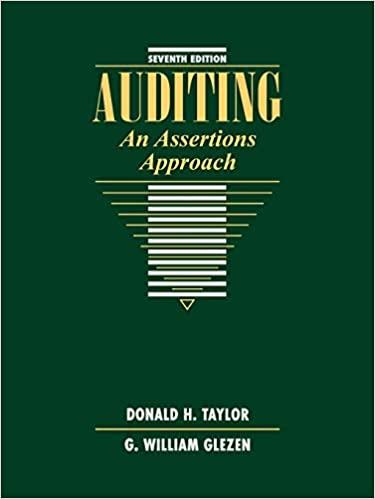The noise of the huge folder dropping on his desk startled Alan Weisner, a new staff member
Question:
The noise of the huge folder dropping on his desk startled Alan Weisner, a new staff member of Kosner \& Kosner. He had recently returned from the firm's staff training school.
"What's this?" inquired Alan as he looked up to Benny Curtz, whose imposing six-foot frame seemed to tower over the small cubicle directly outside the ornate offices of the andit seniors and supervisors.
"It's an audit program for Begin Company, that hardware chain outfit. We're starting the final work this Monday."
"So you want me to look over the program this weekend?"
"Right! Meet me in my office at \(8: 00\) sharp and we'll go over it. That bunch out there at Begin can be pretty cranky, so we need to walk in there as sharp as can be and ready for work."
"Ok," replied Alan sheepishly, "It's just that this weekend I was going to . ..."
"Work in a review of this program," snapped Benny. "Take a long look and make sure you know what we're trying to do out there."
"We're doing the year-end part of the audit, aren't we?"
"This is a lot more messy than anything you saw in training school. These guys have a dozen or more lawsuits against them, and, as usual, they messed up their inventory count and who knows what they're trying to do to make up for it.""
Alan stared at his new audit senior. "And I'm assigned to this audit?"
"Yeah. I asked Susan down the hall to give me someone else who's been around a bit."
"And . . .
"Can't do it. Everyone's tied up. Anyway, you finished first in the training school and Mr. Kosner thought it would be good experience for you."
"Sounds like it," replied Alan. "So I'll look at this program over the weekend and meet you Monday morning."
"Make a list of any questions you have about what you're doing. Begin's controller will spot you as a new auditor the minute you walk in the door. You need to know as much about Begin as possible. I've given you last year's working papers and the permanent file, which includes our proposed audit program. We've already changed it some because of what we found out there last October when we did the internal control work. We'll probably change it some more."
"Ok, Benny, I'll spend a few hours looking at it and make out some questions for you."
At home that weekend, Alan pulled out the section of the working papers that contained a brief history of Begin Company. He read through a description of the company's beginning as a neighborhood hardware store and current situation as a 10 -store chain that covered all the metropolitan area. Next, he carefully reviewed last year's working papers, paying particular attention to attorneys' correspondence and the work done on Begin's large inventory. Then, he looked at this year's proposed audit program and the preliminary financial statements for the year ended December 31, 19X8. Finally, Alan turned on his personal computer, created a file, and began typing out questions he would ask Benny Curtz Monday morning. Here are some of his questions.
1. Why did we assess \(\$ 3,500\) as the total materiality for the financial statements? It looks to me like their listed inventory of \(\$ 280,000\) could be misstated by at least that much.
2. In what way will all these pending lawsuits affect our materiality assessment? I learned in my auditing course and in the training school that these types of things had to be considered, but I'm not sure how.
3. I noticed that the audit program uses the audit risk model on each assertion the way I was taught in school. But I have some questions on it.
a. Why are we using a 5 percent audit risk on each assertion? The problems that Begin has had with its inventory counts and perpetual inventory seem to indicate that most of our work should be in that area.
b. For Prepaid Expenses, Equipment, and Buildings, you have inherent risk and control risk assessed together. The total dollar amount of these accounts on Begin's 12-31-X8 balance sheet is \(\$ 720,000\) of the total assets of \(\$ 1,370,000\). Isn't there some difference between the two risks for these large accounts?
c. At the same time, you assign a high inherent risk to cash even though it's only \(\$ 150,000\) of the total assets of \(\$ 1,370,000\). I know hardware stores have many cash registers and open spaces. But why spend so much time on such a relatively small amount that has never been troublesome?
4. I'm a little curious about our sampling plans. For example:
a. Why are we checking every bank reconciliation for Begin's cash account? Is this a function of the high inherent risk we put on all the assertions for the cash account?
b. We plan to look at every purchase transaction from December 15, 19X8 to January 15, 19X9. Why such a long period? Cutoff problems fall near the end of December, don't they?
c. Will the agreement with the bank on its long-term debt be considered in deciding how much work to do on the \(\$ 450,000\) of notes payable? The bank requires that certain ratios be maintained.
d. Why are we sending out such a large sample of letters to accounts payable creditors?
On Monday morning, Alan met with Benny and presented him with a list of questions, some of which are shown above. Benny looked wide-eyed at the list for a few minutes, but slowly began to answer them, trying, as best he could, to be as practical as possible in his replies.
Required
Write the answers you would give to Alan if you were Benny.
Step by Step Answer:

Auditing An Assertions Approach
ISBN: 9780471134213
7th Edition
Authors: G. William Glezen, Donald H. Taylor





